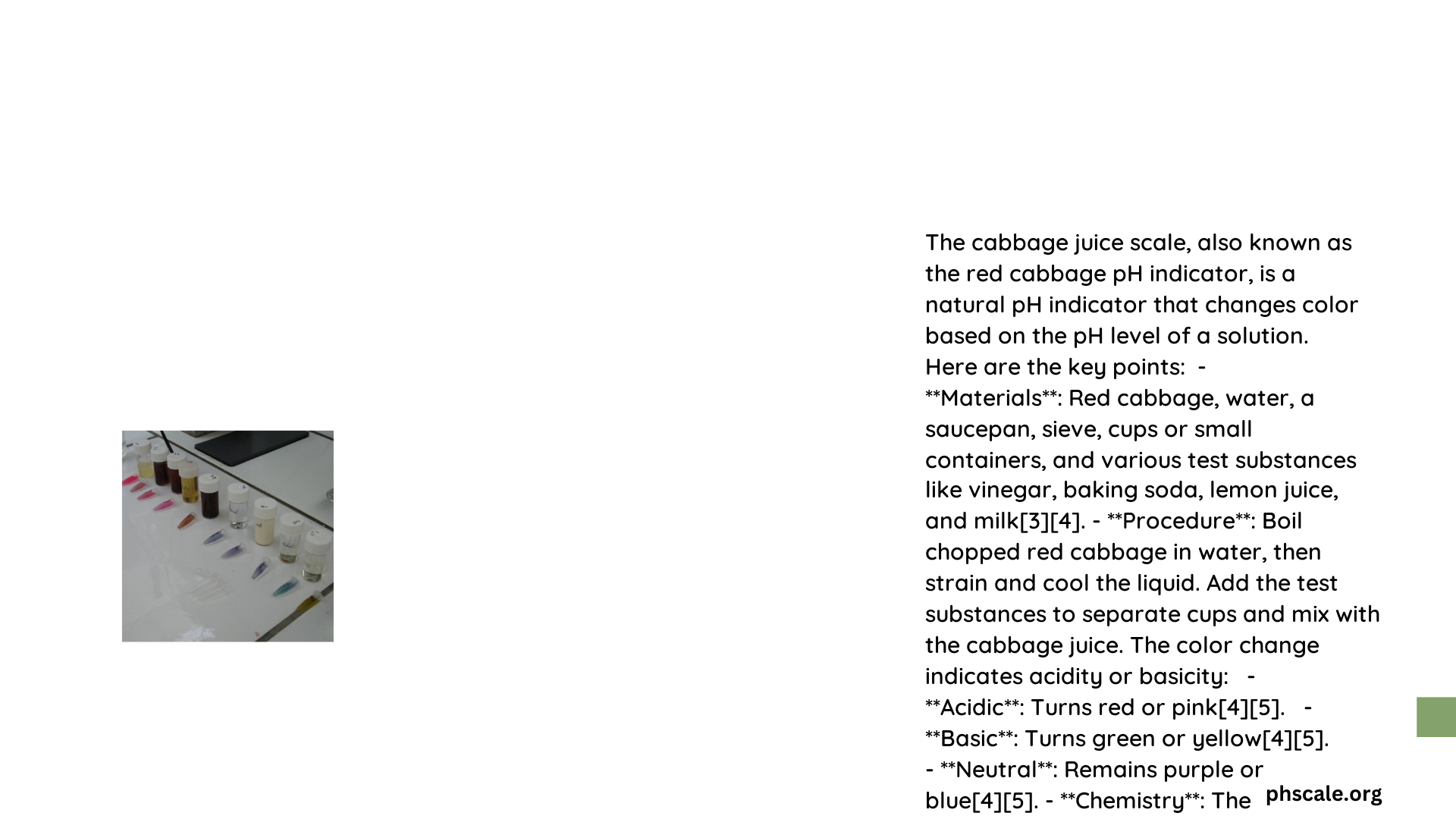The cabbage juice scale is a natural and effective method for measuring pH levels in various substances. This colorful indicator, derived from red cabbage, changes hues across a wide spectrum, allowing for easy identification of acidity or alkalinity. The scale ranges from red in acidic solutions to purple in neutral environments, and green to yellow in alkaline conditions. Its simplicity and accessibility make it a popular choice for educational demonstrations and home experiments.
What is the pH Range of Cabbage Juice?
The cabbage juice scale covers an impressive pH range, making it a versatile indicator for various substances. Here’s a breakdown of its capabilities:
- Full Range: 1 to 12 pH
- Acidic Range: 1 to 7 pH (red to purple hues)
- Neutral Point: 7 pH (purple)
- Alkaline Range: 7 to 12 pH (blue to green to yellow hues)
This wide range allows for the testing of numerous household items and common solutions, from vinegar to baking soda.
How Does the Cabbage Juice Scale Compare to Other pH Indicators?

When comparing the cabbage juice scale to other pH indicators, several factors come into play:
- Range: The cabbage juice scale covers a broader range than many single-color indicators.
- Accessibility: It’s easily made at home, unlike commercial pH papers or electronic meters.
- Cost: Significantly cheaper than electronic pH meters or pre-made indicator solutions.
- Precision: While not as precise as electronic methods, it provides a good general indication of pH levels.
Here’s a comparison table:
| Indicator Type | pH Range | Cost | Precision | Ease of Use |
|---|---|---|---|---|
| Cabbage Juice | 1-12 | Low | Moderate | High |
| Litmus Paper | 4.5-8.3 | Low | Low | High |
| pH Meter | 0-14 | High | High | Moderate |
| Universal Indicator | 1-14 | Medium | Moderate | High |
What are the Steps to Prepare Cabbage Juice for pH Testing?
Creating your own cabbage juice pH indicator is a straightforward process. Follow these steps:
- Gather Materials:
- 1 red cabbage
- Knife
- Boiling water
- Strainer
-
Glass container
-
Prepare the Cabbage:
- Chop the cabbage into small pieces
-
Place in a large bowl
-
Extract the Juice:
- Pour boiling water over the cabbage
- Let it steep for 10-15 minutes
-
Strain the liquid into a glass container
-
Store the Indicator:
- Allow the juice to cool
- Transfer to a sealable container
- Refrigerate if not using immediately
Your homemade pH indicator is now ready for use!
What Factors Affect the Accuracy of the Cabbage Juice Scale?
Several factors can influence the accuracy of your cabbage juice pH indicator:
- Cabbage Freshness: Fresher cabbage typically yields more vibrant and accurate results.
- Water Quality: Use distilled water for the most accurate readings.
- Temperature: Extreme temperatures can affect color changes.
- Light Exposure: Prolonged light exposure can degrade the indicator.
- Contamination: Ensure all tools and containers are clean to prevent skewed results.
To maintain accuracy, store your indicator in a cool, dark place and prepare fresh batches regularly.
How Can the Cabbage Juice Scale be Used in Educational Settings?
The cabbage juice scale offers numerous educational opportunities:
- Chemistry Lessons: Demonstrate acid-base reactions and pH concepts.
- Biology Experiments: Explore plant pigments and their properties.
- Environmental Studies: Test soil and water pH levels.
- Art Projects: Create color-changing paintings or crafts.
Here are some specific experiment ideas:
- Household pH Testing: Test common items like lemon juice, milk, and soap.
- Acid Rain Simulation: Use the indicator to show the effects of acid rain on water pH.
- Cooking Chemistry: Demonstrate how cooking processes affect food pH.
What are the Limitations of the Cabbage Juice Scale?
While the cabbage juice scale is a valuable tool, it’s important to understand its limitations:
- Precision: It provides a general range rather than exact pH values.
- Colorblindness: May be challenging for individuals with color vision deficiencies.
- Shelf Life: The indicator degrades over time, affecting accuracy.
- Interference: Some substances may react with the indicator, altering results.
- Extreme pH: Very strong acids or bases may bleach the indicator.
For applications requiring high precision, professional pH meters or lab-grade indicators are recommended.
How Does the Nutritional Content of Cabbage Affect its Use as a pH Indicator?
The nutritional profile of cabbage contributes to its effectiveness as a pH indicator:
- Anthocyanins: These pigments are responsible for the color changes.
- Vitamin C: Acts as a natural preservative, extending the indicator’s shelf life.
- Fiber Content: Helps in the extraction process by holding the pigments.
Nutritional Breakdown (per 100g of raw cabbage):
– Vitamin C: 36.6 mg
– Vitamin K: 76 µg
– Anthocyanins: 322 mg (in red cabbage)
The high anthocyanin content in red cabbage makes it particularly suitable for pH indication.
What are Some Advanced Applications of the Cabbage Juice Scale?
Beyond basic pH testing, the cabbage juice scale has several advanced applications:
- Soil Analysis: Farmers and gardeners use it to quickly assess soil pH.
- Water Quality Monitoring: Environmental scientists employ it for preliminary water tests.
- Food Science: Used in studying fermentation processes and food preservation.
- Textile Dyeing: Natural dye enthusiasts use it to create pH-sensitive fabrics.
- Forensic Science: Can be used in crime scene investigations for preliminary pH tests.
These applications demonstrate the versatility of this simple yet effective pH indicator.
In conclusion, the cabbage juice scale offers a fascinating blend of science and everyday practicality. Its wide pH range, ease of preparation, and educational value make it a valuable tool for both casual experimenters and serious scientists. While it has limitations, its accessibility and natural origin continue to make it a popular choice for pH testing across various fields.
References:
1. Chapter 7 Measuring the Amount of Ascorbic Acid in Cabbage
2. Test the Rainbow: Using Red Cabbage Juice as a pH Indicator
3. Science At Play: Red Cabbage Juice Indicator
